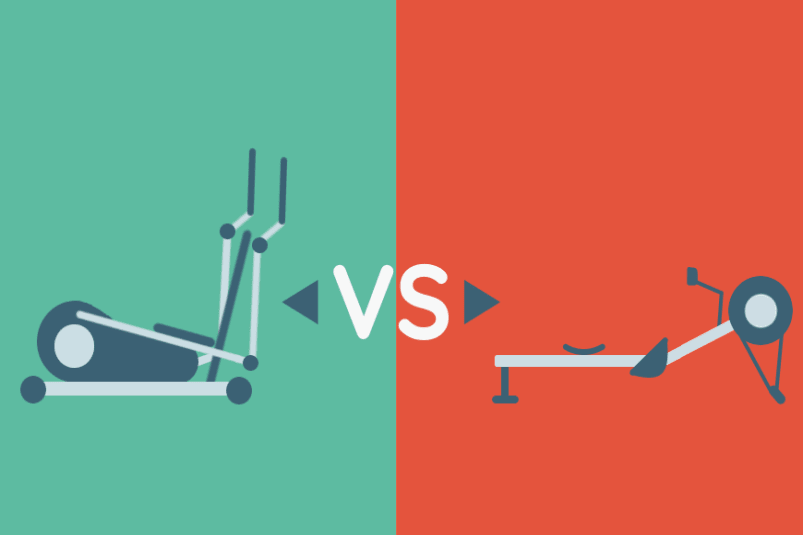Rowing Machine vs Cross Trainer: Which is Better?

Are you unsure between buying a rowing machine or a cross trainer? The rower seems more demanding, is it however more effective than the cross trainer to lose weight? Can you build muscle and strengthen your thighs, buttocks, and legs with it as well? With knee or back issues, shouldn't you avoid the rower?
To discover the differences, benefits, and disadvantages between the rowing machine and the cross trainer, read our comparison!
1) Cross Trainer or Rowing Machine for Weight Loss?
By using either a cross trainer or a rowing machine, you ca burn calories and fat effectively! Both fitness machines offer an efficient cardio workout. They also provide you with the option of increasing the resistance level to vary your workout intensity and allow you to burn more calories.
Rowing machine vs. elliptical trainer: Which fitness machine burns the most calories?
You can burn the same number of calories by exercising on the rowing machine and on the cross trainer. They both use a similar principle: you turn a wheel using the strength of your legs and arms.
- 475 Kcal (rowing machine) vs 455 Kcal (cross trainer) for 1 hour of moderate intensity exercise
- 855 Kcal (rowing machine) vs 830 Kcal (cross trainer) for 1 hour of vigorous exercise
Based on that comparison, one thing is clear: The number of calories you burn depends on how long and how hard you work out, whatever the fitness machine you use. For example, the calories you burn on a cross trainer or a rowing machine in an hour of intense training is around 800-850, and only half that during a moderate workout. It's also important to know that the higher the intensity, the more difficult it is to exercise for a long period of time. So which cardio machine is better then?
Isn't the home cross trainer more effective than the rowing machine at losing weight?
They both help you lose weight, but it's much easier to do one or even two hours on the elliptical machine than on the rower. A workout on a rower lasts about 20 minutes, while one on an elliptical trainer can last up to 2 hours! With the rowing machine, you must contract your muscles more, bend your knees significantly, and put a lot of effort to pull the oar, which is quite exhausting, whereas with the elliptical cross trainer, you can keep a steady workout position while exerting less effort. And it's much easier to exercise at a very low intensity on the elliptical machine that on the rowing machine.
Last but not least, elliptical machines allow you to alternate extended cardio workouts and short HIIT workouts, which is a very efficient way to burn calories and fat and to lose weight. (see How to lose weight on a cross trainer)
HOW TO LOSE 1KG IN A MONTH?
You can lose 1 kg per month by exercising on a cross trainer for an hour 3 times a week, or by rowing for 30 minutes 3 times a week for 2 months.
2) Elliptical machine vs rowing machine: Which muscles are used?
Cardio fitness machines, such as the exercise bike, the cross trainer or the rowing machine, exercise the most important muscle of the body, the heart! Plus, they firm and refine muscles, without making them swell as weight lifting would.
Another common benefit of the rower and the cross trainer is that they can help you strengthen your leg, thigh and buttock muscles. In order to lose weight and become more athletic, it is crucial to strengthen the weakest parts of your body.
Compared to the exercise bike, the rowing machine and the cross trainer engage more muscles. In rowing, the legs provide 60% of the effort, the arms 10% and the last 30% come from the pendulum movement. During a cross trainer workout, arms and legs work simultaneously. Here are the muscles that the cross trainer and the rower exercise:
- leg muscles (hamstrings)
- thigh muscles (quadriceps and hamstrings, at the front and back of the thighs)
- gluteal muscles
- calf and anterior tibial muscles
- arm muscles (biceps, triceps)
- muscles located at the level of the shoulders (deltoids)
- back muscles (large dorsal, trapezoidal and rhomboid muscles)
- abdominal muscles
The advantage of the rowing machine and the cross trainer over the stationary bike is that they work the muscles of the arms, shoulders, back and abdomen, while the exercise bike essentially works the muscles of the lower body.
Is the rowing machine more efficient than the cross trainer to strengthen the thighs?
It is possible to increase resistance on both fitness machines to make the thigh muscles work harder, since the higher the resistance, the harder the muscles work. I would say that both are as effective when it comes to strengthen the thighs and the buttocks.
And to strengthen the arms?
If you want to build your arm muscles (biceps and triceps) and tone them up, then the rowing machine is probably what you need! The cross trainer also exercise the arms but to a lesser extent that the rower.
WHAT YOU SHOULD KNOW:
To gain muscle mass, you'll need to increase the resistance on your home elliptical trainer or rowing machine! You'll also burn more calories this way! No pain, no gain ;)
3) Elliptical machine or rowing machine when you have knee or back problems?
It is true that the rowing machine makes the back stronger, but it is also true that people who already have back pain or poor posture may feel more pain by using it intensively. Rowing machines also force you to fully bend your knees, which should be avoided by anyone with knee problems.
The same is true for the elliptical machine, though to a lesser extent. It is good for strengthening the back muscles but one should be very careful since some movements may worsen the back pain. Generally speaking, cross trainers are a no-impact sport that can be used at any age.
Rowing machines aren't recommended for people who have back or knee problems. The cross trainer may be used in such cases but with caution. For the elderly, the cross trainer is more suited since it's a low impact exercise.
The ideal fitness machine for people with knee or back problems is the stationary bike. As you ride on a stationary bike, your back is barely strainy and your joints are not knocked. (see our article about the exercise bike against back problems).
WHAT YOU SHOULD KNOW:
It is important to have the right technique when using a rowing machine to prevent back pain! Make sure you use your legs first, then the seat backward, and lastly your arms. Repeat the process the other way around (extend your arms, slide the seat, then bend your legs).
4) What are the other pros and cons of the rowing machine and the cross trainer?
Cardio machines such as the rowing machine and the elliptical cross trainer benefit the body's heart and cardiovascular system, improve fitness and endurance, and allow you to lose weight and strengthen your legs, thighs and buttocks.
In the end, it's more a matter of taste: do you prefer running or rowing? Do you want to sit while exercising or stand? Do you want to do HIIT exercises? Do you want to work out at a moderate intensity for one hour or perform a demanding workout on your rowing machine? What sensation are you looking for? Amateur or professional rowers will prefer a rowing machine, and joggers a cross trainer.
Another difference is that you can accelerate naturally on the rowing machine, try to go as fast as possible in order to beat your best time. The cross trainer is not designed to make you run as fast as possible. You can certainly move your legs faster but up to a certain speed. The rowing machine is probably more competitive and will appeal more to people who like that component.
If you want to exercise regularly, between 30 minutes and 1-2 hours a day, a home cross trainer such as the DKN XC-140i is an excellent choice. For home rowing machines, our favorites are the rowing machine by Circuit Fitness or for smaller budgets the folding rowing machine by Sunny Health & Fitness.
Ideally, you should exercise 30 to 45 minutes on your cross trainer or rowing machine two to three times per week. This way you'll fully enjoy the benefits of exercise and its positive effects on your health.

Clara Miller
Fitness Writer
Clara Miller has a Master's degree in Sports Science and has worked for famous sports and fitness brands. She is passionate about sports and regularly writes about fitness, weight loss and motivation for various blogs and magazines.
